Text
The new reality or fiction: Contemporary photography
Created by:
Angel Kyna Canazares
Kevin Dela Cruz
Jayhan Klassen
Jaryelle Pilar
Alterations are not allowed in press photography, but they are one of the tools used in contemporary art photography? Why?
According to the guidelines of ethics of photojournalism, editing pictures of any kind is not advised for journalistic purposes. ‘Accuracy is the moral imperative of journalists and news organizations, and should not be compromised, even by pressing deadlines of the 24-hour news cycle’ (Ethics Guidelines). For example, staging, re-enacting, or manipulating events, adding or removing content during photocapture or post-production would change the perception of events, thus influencing the intended audience one way or another. Keeping photographs' original form and state is an ethical responsibility for photojournalists to maintain their neutral position of truth and avoid manipulating the exact message that is shown in reliable news channels such as newspapers, television and serious social media platforms. However, in contemporary art photography, neither a photographer’s message nor the process has to follow the ethical guidelines that photojournalists have to adhere to. Because the purpose of photography in an artistic context, is to convey the vision of the artist. The message is open to interpretation and the audience is encouraged to develop various perceptions of it’s meaning, whether it is hidden or obvious. This artistic process of photographic artworks allows the photographer to have freedom in both the image capture and the post-production processes. This is encouraged and expected of the photographic artworks, as simple documentation of reality is deemed not sufficient enough any longer to give a photograph an artistic merit.
What happened to the photography? Is this its future? By Cruz
When we compare the photos taken from Adams, Sommer, and Klett and Parke to Harrison, Muniz and Crewdson’s work they all have very different photographic styles. They have different preferences of how they like to take pictures for example. When you look at Adams, Sommer, and Klett’s photos, they portray realistic images by using the elements around them such as nature, landscape and the people in the image. Their photos have been barely touched up by any editing software or by altering it in the darkroom. This gives us the raw and realistic emotions when we see their images. When we look at these images through the lens of NPPA ethics they would pass as press photos due to the minimal use of either digital software or altering of the image in the dark room.
On the other hand, Muniz, ParkeHarrison, and Crewdson all have a different approach when it comes to getting their audience’s attention. When they take photos of others they use properly placed objects or people, colour and lighting to turn their imaginations into reality. Looking at the images for the first time, we saw a different kind of creativity in the photos, compared to Sommer, Adams, Klett’s realistic photos. Muniz, ParkeHarrison, and Crewdson were more art photographers rather than press photographers due to the creative process that they follow as well as the alterations made in the photos. In our opinion, these future photographers want to be more creative and have more freedom when it comes to representation of their artistic vision. Art is all about expressing a vision and/or feeling whether it's utopic or real. The process or the medium of photography is altered to serve this vision and this appears to be the future.
Compare photographers of Sommer, Adams and Klett versus Parkeharrison, Muniz and Crewdson.
Mark Klett VS Shana & Robert Parkeharrison by Pilar
Mark Klett
Mark Klett is a famous American photographer. Through Klett’s photography, his form of style is linking cultures, landscapes and time. Some of his famous works are from the Grand Canyon where he and his former student Wolfe were able to recognize the accurate locations portrayed in Klett's geographic points from his original overview. His versions of the historic views are being inserted within the modern photographs that are built in a panorama. The reason behind this style or rather this creative idea of Klett is to highlight possible or multiple interpretations of a single scenery or rather the landscape. Most of his works are a mashup of different photographs inserted to an old picture that was taken years ago and new pictures that he took are being attached at the same place. “So much of what we know, and what we think we know, about the land has first passed through someone’s lens. The interesting thing is to make use of this history, not merely to be absorbed into it. For me, landscape photographs begin as the artifacts of personal moments. They get interesting when they become cultural commentary.” - Mark Klett “I am not much interested in discovering new territories to photographs. Instead, what I wish my pictures could do is lessen the distance one often feels when looking at landscape photographs… The longer I work, the more important it is to me to make photographs that tell my story as a participant, and not just an observer of the land.” - Mark Klett

North Rim by Mark Klett
Shana and Robert Parkeharrison
Shana and Robert Parkeharrison are a husband and wife team who have been taking photographs together for almost 20 years. Their style in photography focuses more on the relationship between humans, nature/environment and technology. In their photographs, they include a touch of painting techniques, for example, using a collage technique creates a cinematic story of the environment. Their creativity in their works is very unique due to the way they interpret and figure out how an audience would communicate with the image being shown. Moreover, they utilize multiple styles as some of their works have an effect of being very dramatic with dreamy qualities by the use of photogravures.
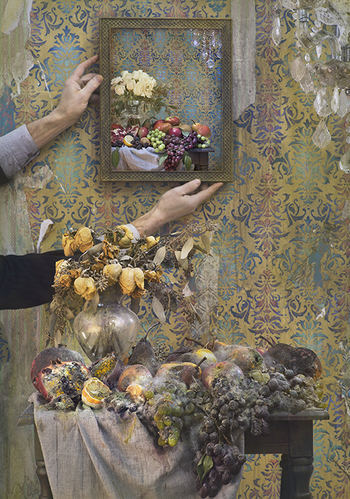
Nature Morte, 2015 by Shana and Robert Parkeharrison
Fredrick Sommer VS Vik Muniz by Canazares
Fredrick Sommer
Fredrick Sommer Adam was born in Angri, Italy but he was raised in Brazil. At first, he studied and focused more on landscape architecture. He was then introduced to using watercolours and that involves pen and ink where eventually led him to have his first exhibition of watercolours. His creativity then evolved where he experimented with photos using double exposure. His photographs are aesthetically pleasing landscapes that range from disorienting with macabre aspects of the natural world to surreal arrangements of found objects and pure abstractions.
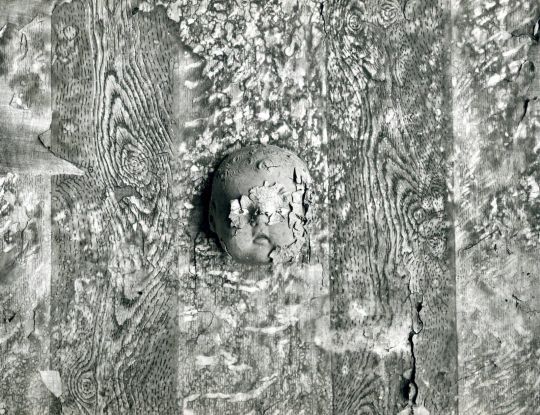
Medallion, 1948 by Fredrick Sommer
Vik Muniz
Vik Muniz is born in Sau Paulo Brazil. He was born and diagnosed with Dyslexia. Through his form of style in art photography, his creativity is very distinctive. Through his art he was able to recreate iconic, historical artworks from found materials like trash; a form of layered appropriation. Through all his works, Muniz’s art makes us question through illusion and perception. Muniz has said that he does not believe in originals, but rather believes in individuality. Indeed, in his photo manipulation and methodology, he truly creates signature works that repurpose and showcase themes in different lights for his viewers. He sees photography as having "freed painting from its responsibility to depict the world as fact." (Ollman, 2020).
“Things look like things, they are embedded in the transience of each other’s meaning; a thing looks like a thing, which looks like another thing, or another. This eternal ricocheting of meaning throughout the elemental proves representation to be natural and nature to be representational.”
- Vik Muniz
“Creation is something that represents a graspable portion of what we can observe but cannot understand. Creativity is how we cope with creation; it’s how we invent languages, motifs, and patterns to actually help us navigate in an otherwise really complex structure of events and situations. All we do is try to cope, ultimately. Creating opened ended structures, and ways in which you can approach or think about reality is the ultimate role of the artist. You have to be very dedicated to the concept of Realism.”
- Vik Muniz
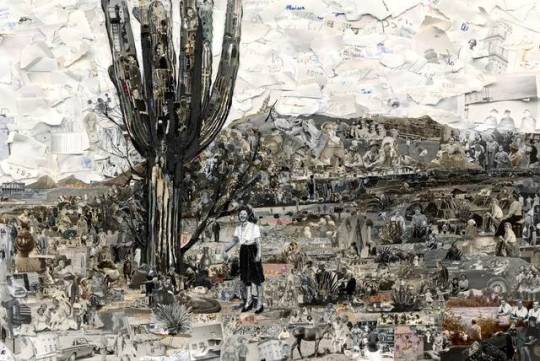
Sanora, 2014 by VIk Muniz
Gregory Crewdson VS Robert Adams by Klassen
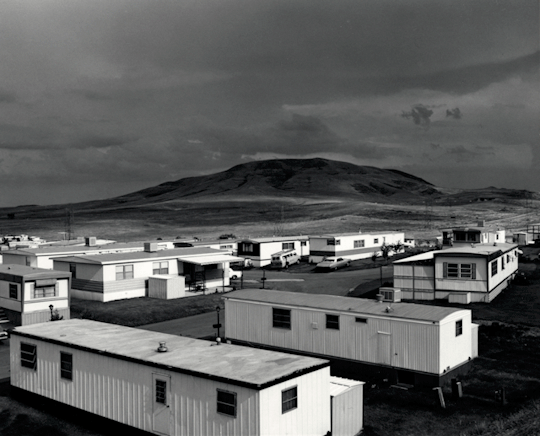
Mobile Homes, Jefferson County, Colorado by Robert Adams
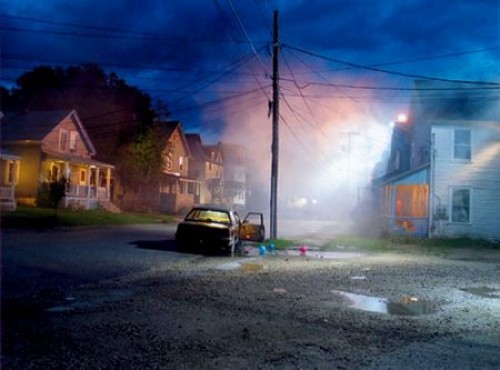
Production still (Clover Street #2), 2005 by Gregory Crewdson Robert Adams
Robert Adams (1937) got into photography in his mid-twenties, primarily focusing on the changing architecture and landscape of the American West in the early 60s. This quote summarizes his observations of human altered landscapes and desire to photograph the rapidly changing architectural suburbs. Photography allowed him to engage in his love of outdoors while providing him a vehicle to contribute to society.
‘I came back to Colorado to discover that it had become like California. . .. The places where I had worked, hunted, climbed, and run rivers were all being destroyed, and for me the desperate question was, how do I survive this? Edward Hopper’s paintings had already given me a clue, though I didn’t fully understand it.’ (Yale University Art Gallery)
His work was informed by photographers like Lewis Hine, Edward Weston, Dorothea Lange, and Ansel Adams who merged their social concerns with their artistic vision in landscape photography. As we can see in his pictures entitled Mobile Homes or Summer Nights Walking, he was interested in capturing the banal and the mundane in this new altered landscape without photographic alterations. This is also clear in his quote stating that ‘[w]hatever power there is in the urban pictures is bound to the closeness with which they skirt banality. For a shot to be good—suggestive of more than just what it is—it has to come perilously near being bad, just a view of stuff.’ (Yale University Art Gallery)
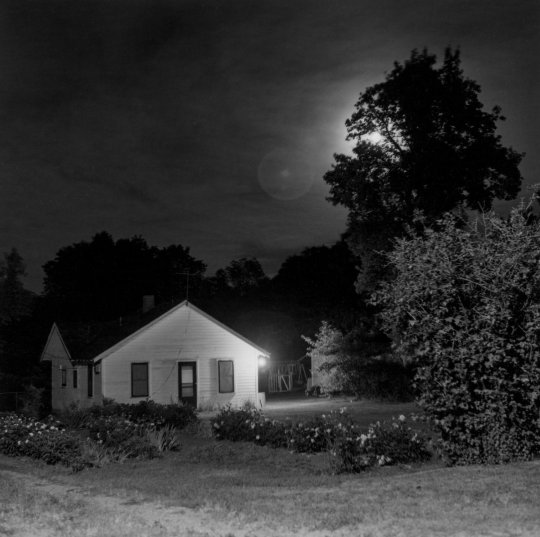
From Summer Nights Walking, 1976-1982 by Robert Adams
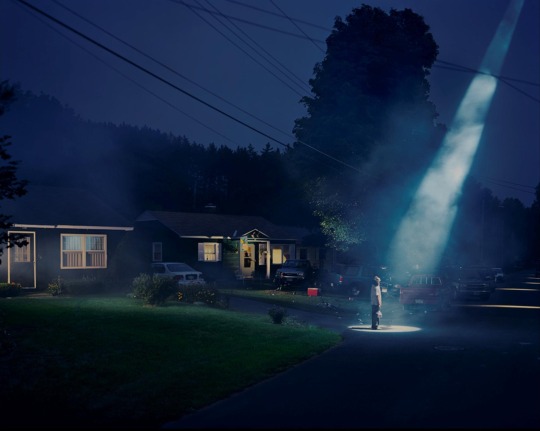
Twilight (Beer Dream) (1998) by Gregory Crewdson
Photo: courtesy Photology Gregory Crewdson
Gregory Crewdson (1962), much like Adams, is also interested in man-made or the natural American landscapes, although for a couple of decades after Adams in time period. However, unlike Adams, Crewdson is well known for staging elaborate and eerie shots of suburban people and homes just like in a movie scene. He was influenced by film makers such as Steven Spielberg, Diane Arbus, and Edward Hopper. He uses a crew just like in movie sets and works with a director of photography. He uses various stage lighting sources and strobes. Therefore, his photography looks more staged and makes people wonder whether they are looking at a photograph or a disturbing crime scene or a surreal image from a movie! He has an elaborate post production process to achieve these sensations in a viewer.
‘It begins with him looking through contact sheets alongside a retoucher. Often his images are pieced together from multiple exposures. Even the retoucher remarks that it’s rare that he chooses the final image from one single exposure, it’s often more composites of multiple photographs all with unique elements that capture what he’s looking for’. (Wilson, J)
If we examine Adams’ Summer Night Walking, one can imagine him setting up his tripod and waiting to capture the suburban home under the perfect moonlight. The image is black and white and no editing is done. Crewdson in his Twilight (Beer Dream) shoots a similar suburban scene, however, we can tell from the lighting and the atmospheric effects that this is staged like a movie scene and there is nothing real about it. Also, the people he places in his photography implies that there is a narrative story to his photographs beyond what is visible on the still image just like in a movie script. Because of the photograph’s surreal quality, we know that this photograph is edited many times and has an extensive post-production process with colour/atmosphere alterations to achieve the drama in Crewdson’s artistic vision.
Will photography capture the reality or it will be only fictional?
To determine whether a photograph will capture reality or will it be fictional depends on the context. For example, if an artist is using photography and inserting images or objects into another picture from his imagination just like in a painting, that would be fictional. They may partially capture reality but we, as the viewer, do not know that until we read more about the photograph in question.
When capturing reality, we think the image has to be accurate and genuine. The main purpose of taking a realistic picture of an object or people is to achieve art and the true representation of the content. Photographers such as Sommer, Adams, and Klett, their artistic style of photography emerges from the presentation of a real situation, site, building or landscape. Their photographs are viewed as very realistic and raw because of the lack of alterations after and showing the stark reality of the context. Sommer, Adams and Klett’s style in photography evolved from capturing what was out there; natural and man-made, something we see with our naked eye. Therefore, we think this photographic style and creativity are much more appealing than fictional photography because we can see the originality which then leads us to believe in what we see in the image.
On the other hand, photographers such as ParkeHarrison, Muniz, and Crewdson took pictures that turned their imagination into reality, the medium giving them the freedom to turn whatever they imagined into a photograph. This is considered in our opinion fictional photography. For example, Crewdson’s fictional style expressed in photographs can be used for a movie ad, a book cover or to attract viewers in galleries who wonder what the photographer had in mind just like in a painting.
Any photo could be real or fictional. However, in the strange times that we live in where we are bombarded by fake images and news every moment, the realistic photographic style stands out as a genuine art form that we can relate to without being deceived.
Bibliography
ArtNet Worldwide. (2020) Vik Muniz. Vik Muniz Biography – Vik Muniz on Artnet, Retrieved from www.artnet.com/artists/vik-muniz/biography.
Carovalbuena, |. (2015, March 31). The new reality or fiction: Contemporary Photography. Retrieved from https://carovalbuena.wordpress.com/2015/03/31/the-new-reality-or-fiction-contemporary-photography/
Ethics Guidelines (n.d.). Retrieved from https://caj.ca/ethics-guidelines
Foodlovecobyduane. (2018, November 28). The new reality or fiction: Contemporary photography. Retrieved from https://foodlovecobyduane.wordpress.com/2018/11/28/the-new-reality-or-fiction-contemporary-photography/
Frederick, and Frances Sommer. (2020) Frederick Sommer: Center for Creative Photography. Frederick Sommer | Center for Creative Photography. Retrieved from ccp.arizona.edu/artists/frederick-sommer.
Klett & Wolfe. (2020). Charting Canyon. Retrieved from https://www.klettandwolfe.com/images/ChartingCanyon%20brochure%20PAM.pdf
Knight, Chris. (2013). Amazing Surreal Work from Robert & Shana ParkeHarrison. Fstoppers. Retrieved from fstoppers.com/portraits/amazing-surreal-work-robert-shana-parkeharrison-4009.
Muniz, Vik. (2020). Vic Muniz. VikMuniz. Retrieved from vikmuniz.net/.
Musee. (2012, 13 June). Meet the Photographer: Vik Muniz. Musée Magazine, Musée Magazine, museemagazine.com/culture/art-2/features/meet-the-photographer-vik-muniz.
Parkeharrison, Robert & Shana. Robert and Shana ParkeHarrison. Artspace. Retrieved from www.artspace.com/artist/robert_and_shana_parkeharrison.
Robert and Shana ParkeHarrison. (2020) Artspace. Retrieved from www.artspace.com/artist/robert_and_shana_parkeharrison.
Sommer, Frederick. (2017). Frederick & Frances Sommer Foundation. Retrieved from www.fredericksommer.org/.
Wilson, J. (2016, December 15). An In-Depth Look at The Work of Photographer Gregory Crewdson. Retrieved from https://www.thephoblographer.com/2016/12/15/reserve-channel-takes-depth-look-work-gregory-crewdson/
Yale University Art Gallery. (1980). Robert Adams: The Place We Live: Yale University Art Gallery - Chronology (1962). Retrieved from http://media.artgallery.yale.edu/adams/chronology.php?y=1962
0 notes
Text
Made by Jaryelle Pilar


Photography has been one of my favourite things to do. It has been a form of expression in the things I see and feel in the moment of a certain view or object. The power of photography has a lot of varieties of meanings and perspectives with just a click. Sometimes I use photography as a tool to capture a special moment that I find very memorable and I use that to share it with the world because it had created and impacted me with a huge expression such as joy, curiosity, or could simply be sadness. Photography also encourages me to be creative and develop a personal style where I try to shift from a different view that not a lot of people would feel and once I edit it and match it with a caption to represent it, I received a lot of people saying that they find it very impressive or innovative. From that on, I decided to practice even more and join classes related to photography. I may not be as perfect or let’s say as professional; however, I do believe that it will take a lot of practice and for this assignment, the two pictures that I will compare between original and edited, will show a shift of story.
Lately, I had been very interested in watching horror films and then I got so interested to edit 2 pictures from my original shots that I took in Canada. Picture (A) attached above that I entitled “Horrific Existence” is where I got inspired to edit the original picture to a view of loneliness or could be a sense of horror like the TV series called “The Walking Dead”. When I was editing the picture, I focused more on a black and white filter where I edited the exposure, lighting, shadow and brightness of the overall photo. The point of changing the colourful picture to black and white is because I aim to shift their perspective to something different; from joy and happiness to an impact of loneliness. For me to test and try to prove my edited picture to see if I did achieve to shift a different perspective, I did a short interview from my classmate named Shaina where she states that the original picture felt so relaxing and where she would see herself going to that place and be happy. She also said that she sees herself going there with her family. However, when I showed her the edited version of the picture, she suddenly felt lonely and felt different. She mentioned that she felt as if she was in an apocalypse where the world flips to something horrible and that she does not see herself living in a place like that because she would feel afraid and terrified.
A week ago, I was watching a scary and very daunting movie called Anabelle. In the movie, Anabelle was believed to be a normal doll but it was actually possessed and haunted and as you stare at the doll for a long time, it will slowly give you the feeling of being creeped out. Picture (B) attached above that is entitled “The Glimpse” is where I got inspired to edit the original picture to a view of darkness. I also focused more on a black and white filter with also fixing its exposure, lighting, shadow and brightness; although, I did put a colour in the eyes of the cat. I only coloured the eyes of the cat and made it more vivid to achieve a scary or an eerie effect; moreover, by colouring the eyes, it can help people identify the object of the edited picture. For me to verify and see the result if I was able to accomplish to shift and mesmerize by the edited picture, I did a short interview from my classmate Anna where she states that the original picture is something she would just scroll if she saw in social media or in a book where she would not pay attention to. Nonetheless, when she was looking at the edited picture, she finds it very creepy and more dramatic; furthermore, she said it gave her the feeling of a darker mood and when she saw the eyes, it makes her want to stare at it even more where she finds it very hypnotizing. Also, she mentioned that if she saw this particular picture in her feed or saw this in a book, she more likely pay attention and would read the caption or the story behind it.
The edited pictures from picture A and B will misguide the audience. Editing pictures and showing it to people will impact them because when filtering and changing its original form, it will change and cause a lot of different perspectives. Edited pictures should never be used in news media because it will disobey the rules of photojournalism. Photos that will be shown on a serious platform such as news on television or in social media should always follow the ethics of photojournalism. The rules in photojournalism are to always report and show relevant facts about a certain event that people or the public would receive the real information. It should never change the real meaning of it or rather the information behind it so that it will not lose its real reason and purpose. Knowing that each original picture that took was changed into black and white is not allowed to be used in the serious platforms. Anything you change from colour, filters, shapes, no matter what you edit, should not be presented as a press photograph because you are not documenting the real event. In terms of the main differences between art and press photography, they are absolutely different. Press photography is where you report the current event and the aim is to capture an experience that also supports a written report; therefore, it should not be edited of rather changed from its original view. However, for art photography, the method of communication is not through the event that has happened but through the artist. The artist may try to show something that will achieve an effect by the message that could be through words, emotions or just simply a creative idea they thought of. The use of art photography is to build up an emotion or behaviour to be able to appreciate their work. In terms of identifying which one is press or art photography, the original pictures that I took are press photography since it is showing it natural raw pic and for the edited pictures are considered as art photography since I was aiming to give a different view and by editing the picture, it was able to achieve a different story and perspective.
Editing a picture will simply lose its authenticity. There is nothing wrong with editing pictures unless if you use it to report a situation, then that is something you would not consider. Editing photos through reporting is not advisable and would disobey the ethics of photojournalism. Don’t be scared, as long as you use it for something else such as a form of expression for your own art then there is nothing wrong with that. In photography, always be creative and have fun.
REFERENCES: - DB 6 (Week 6) Documenting the great depression - DB 9 (Week 9) Shooting the truth: Photojournalism
All pictures that are used are owned by Jaryelle Pilar.
0 notes
Photo

This photo is a reflection coming from the lens of my sunglasses. To most people, it is just an ordinary street view, to me, it is a vision of dreams and ambition.
This was taken in the Philippines, it’s a highway that runs through multiple provinces in the Philippines.
1 note
·
View note